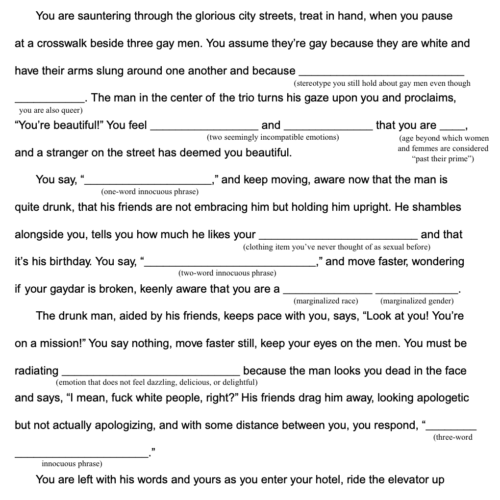I recently transcribed one of my husband Séan’s bedtime stories onto a gold nightdress of mine in gold ink. In the daylight, the words shine above the matte gold fabric, but at night the ink disappears, and I fear his story is lost.
I search for it, prospecting letters hidden in the thread, the weave, the seams, holding the fabric up to a lamp. I panic that the story has become saturated, the gold fabric subsuming the cursive. Could my dress devour a story?
Séan once wrote: I watch the ink recede further from the nib of my pen until I am only dipping in a well of clear water and tracing translucent lines across the page.
I fear I’ve been writing with disappearing ink, too, the way my daughters and I used to write spy messages in lemon juice, messages you could only read by holding up to candlelight. I hold my gold dress to flame, but it bites its tongue; keeps its secrets.
Like the heroine in Rumpelstiltskin spinning gold from straw, I strain to find the golden filament of my cursive writing in the weave of my dress.
By morning the narrative is visible on the fabric again, the thread of my handwriting slightly wider than the threads of the dress. In this light, the words are legible. I wished Séan would embroider the stories into the fabric for me so they could never fade or seep into the weave. Then, if they disappeared, I could read the stitched story by touch.
*
In 2012, the Victoria and Albert Museum exhibited the world’s largest woven cloth made from the gossamer of a million female golden orb-weaver spiders. Séan wrote, “I’ve watched the V&A video you sent. What a shame that we’ve missed the exhibit of woven spider silk textiles. There can be few astonishments left in the known world, but I am astonished. Gold-spinning spiders are part Midas, part Rumpelstiltskin, and wholly glorious.”
In Madagascar, farmers collect the spiders in the wild and keep them in matchboxes. The spiders’ spinnerets release fantastical skeins of golden thread so fine, strong, and lustrous that it needs no finishing before being strung on a loom. Twenty-four spiders create a 24-string warp.
In 1889, van Gogh wrote to his brother Theo, “In Zola’s Le rêve, I found the figure of the woman, the embroiderer, very, very beautiful, and the description of the embroidery all in gold. Precisely because it’s like a question of colour, different yellows, whole and broken.”
I want a million female orb-weavers to weave gossamer cloth around my body, then be released back into the wilds of my imagination.
Is this gold-mining ethical, pressing on the spiders’ spinnerets like tugging on a cow’s udder?
Animals have often been slaves to color. For instance, purple pigment came from the excretions of sea snails; it took thousands to color a small swatch of fabric. The abdomens of female Cochineal beetles are ground to create the vibrant red known as carmine, carminic acid, cochineal, or Red # 4. This is the chief food coloring in the food industry today, found in candies such as Skittles and Swedish Fish and everything from soda to frozen crab.
Gold tones are just as culpable. Indian yellow, famed for its luminescence in Turner’s watercolors of illuminated angels and popular among European artists from Rembrandt to van Gogh, came from the dried urine of cows fed exclusively on mango leaves. Kelly Grovier, in the BBC Culture article “The Murky History of the Colour Yellow” wrote, “some of the most memorable instances of yellow in art history – from the transcendent shimmers of JMW Turner’s lucent landscapes to the troubled music of Vincent van Gogh’s whorling constellations – are caked in cruelty, said to be fashioned from the sickly urine of malnourished cows.”
Thankfully the practice was outlawed around 1908, twenty years after van Gogh painted The Starry Night in the Saint-Paul asylum in Saint Remy, France.
It seems golden orb spiders – the textile equivalent of Indian cows – aren’t maltreated. They’re collected from local parks in the morning and brought to the “spidery” to spin silk during the day. The craftspeople put pressure on the spiders’ abdomens – their spinnerets – and the threads emanating from matchboxes are wound onto spools. At night the spiders are returned to the parks.
*
Séan and I spent a year lounging on a golden damask couch in the south of France in 2020. The floral motif of the velvet nap had been burnished to a blinding gold in the sun. The fabric might have been dyed with Indian Yellow; it was made in the 19th century. The undersides of the cushions were still the original color; a putrid mustard yellow, the color of undiluted Indian Yellow pigment.
I used to write on that couch every day. I was working on a memoir of life in Florence, Italy, living across the street from the Sant’Orsola monastery, where they created gold thread during the Renaissance. The lustrous filaments wove through the finery, bedding, upholstery, tassels, and tapestries of the Medici nobility. Florentine nuns raised the silkworms, harvested the cocoons, unwound the thread, and gave it to goldsmiths who spun filaments of luster around it. It was a booming trade. Nunnery ledgers attest to this; how much thread, how much gold, how many florins per month.
My thoughts flickered between the gossamer of the golden orb spider to the gold threads in Renaissance nunneries, threads that wove through the entire Renaissance, that can still be seen in the costume museum in San Niccolo and portraits worldwide.
*
In my dream of the gold dress, much like Zola’s rêve, Sean was the embroiderer. He kept a golden orb spider in a matchbox beneath my pillow. It spun threads all night, the weight of my head on the pillow providing ample pressure on its spinneret, spurring the production of gossamer. The thread flew across the bedclothes like fine golden hair, and Séan embroidered endlessly as I slept, word after word, never having to stop to thread the needle – the spool infinite and fresh spun from the heat of industry in the matchbox.
Spin has many meanings:
- to draw out and twist fiber into yarn or thread
- to form a thread by extruding a viscous rapidly hardening fluid (especially by a spider)
- to stretch out or extend (something, such as a story)
- to evolve, express, or fabricate by processes of mind or imagination
- an ingenious twist (on something)
Etymology: Old High German: spinnan, to set a trap.
For spiders, the act of spinning is synonymous with setting a trap. The golden orb spider’s silks are so strong that birds and bats often become caught in their webs. Likewise, the gold threads emanating from the matchbox under my pillow would trap the story in the weave of my dress forever.
*
Hair, especially golden blonde hair, has often been portrayed as a deadly lure or trap. In Galia Ofek’s Representations of Hair in Victorian Literature and Culture, she explores Dante Gabriel Rossetti’s painting “Lady Lilith,” whose ‘heavy mass of hair like thick spun gold’ was, for Swinburne, the idea incarnate of faultless fleshly beauty and peril.”
Rossetti published two sonnets along with the painting, telling the story of Lilith with her “enchanted and ensnaring hair” which, according to Odek, is “conceptualized as a feminine trap, a net, a web, and a noose (‘the bright web she can weave,’ not unlike the golden orb spiders).” Not unlike the urban legend of the crosshair.
Crosshairs are the most threadbare webs – just two strands – yet men and villages become caught in them.
Hair is a lure, a trap; it is alluring.
*
Rossetti’s sonnet includes one of my all-time favorite lines of poetry: “Lo! As that youth’s eyes burned at thine, so went / thy spell through him, and left his straight neck bent / and around his heart one strangling golden hair.”
*
If Séan were to spin tales on my nightdress, the words “Once upon a time” would begin on my sleeve, where I rest my head; the first thing I see when I open my eyes. I’d read my arm like a page in a book, flattening wrinkles in the fabric to make out the words.
I’d work my way groggily to my elbow, my shoulder, the bodice, drink my coffee while bent toward my breasts where the story would be written upside-down so I could read it from above, then I’d continue reading the story along the length of my skirt all the way to my toes, hiking the hem farther and farther up my legs to my pelvis, to get to the bottom without straining my eyes.
I’d stumble upon secret messages, too. Little knots in the thread would annotate the main narrative.
The story would continue along my backside. I’d turn the page by turning my body within the dress, taking my arms out of the sleeves, spinning the garment around, and then reading the back of my nightdress from collar to calf.
Imagine – a book whose pages are turned by turning our naked bodies inside of it; a story inspired by the curves and valleys of our sleeping selves; a story that leaves our straight necks bent and around our necks, one strangling golden thread.

Jalina Mhyana
Jalina Mhyana is the author of four volumes of poetry and creative nonfiction. Recipient of the University of Oxford's History of Art essay prize and the Pudding House Press chapbook prize, her work appears in The Southeast Review, The Cincinnati Review, Chautauqua, Lunch Ticket, ROOM, CutBank, The Roanoke Review, among others. A graduate of the Bennington MFA Writing Seminars, Mhyana and her husband live in a 300-year old home in France. http://www.jalina.fr.




